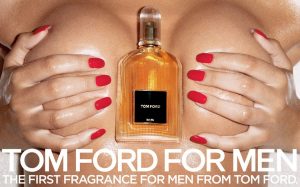Hypersexualization
ORIGINAL ADVERTISEMENT

During the release of Tom Ford’s fragrance “Tom Ford For Men”, a series of ad campaigns were put out in order to garner attention for the product in hopes of escalating its sales. The infamous photographer, Terry Richardson, shot numerous photos of close-up images depicting the fragrance deliberately being placed in-between various female erogenous zones. The ad that I chose is one of the many nude images that were put on the market, exhibiting the “Tom Ford For Men” fragrance placed in-between the breasts of a women whose own hands are just barely covering her nipples. We do not see anything above her breasts, clearly demonstrating the evident objectification of female body parts that are commonly used as commodities to sell products and fulfill men’s “sexual fantasies”. The hypersexualized nature of this ad is problematic; it takes the sexual expressions of women and amplifies it to the public in order to cater to specific audiences and saturate the market. It is common to see hypersexualized female bodies in the media, where the bodies typically belong to Caucasian, slim, tannedwomen, with full busts. More often or not, images of these nearly-naked women are plastered onto ad posters even if the depiction of these bodies have nothing to do with the product at all (e.g fast food burger campaigns). Fundamentally, the question becomes: is the ad trying to sell the product itself, or is is actually trying to sell the sex appeal of the female body?
Further, the implicit message of this ad is that if a man purchases the perfume, it will increase their chances of seducing a female and “getting some action”. It denotes the idea that when a man wears this so-called masculine and mesmerizing aroma, it will automatically increase their sex appeal to a woman. The degrading implication that is being made is that a woman’s expression of her sexuality is only for the appeal of her male counterparts and the fulfillment of their sexual needs. A woman’s choice to express her sexuality through being “provocative” and feeling confident about herself is not the problem. In fact, it can be seen as a form of empowerment, freedom, and de-stigmatization to female sexuality. The problem is how female sexual expression is constantly being exploited by large corporations; the portrayal of women in advertisements is continuously hypersexualized in demeaning ways and objectified through the removal of “humanness”.
JAMMED ADVERTISEMENT

Tom Ford for Men has become “the first fragrance for hypersexuality”. My main intention for my reconstructed ad was to demonstrate the treatment of the female body as an object that is used to hypersexualize the expression of female sexuality. I replaced the picture of the woman’s breasts with an image of a nude Barbie doll, all the while making sure to crop out the face. This choice was made in order to highlight the fact that women are often objectified and de-humanized when it comes to selling products in ads. The women in these ad campaigns are not really seen as a humans, but are seen as some type of attractive, money-making, sex objects instead. Through the removal of their faces, these ads often attempt to suppress the idea of seeing women as actual human beings — detaching their “humanness” through strictly exhibiting their bodies only. The black markings on the Barbie doll represent the pressure that are put onto women to look like those who are traditionally portrayed in ads. Like mentioned, companies often stick to slim, Caucasian women with big breasts while trying to sell products. This generates the idea that women must fit into those traditional standards in order to be perceived as “sexy enough” for others, and for themselves. I modified the name of the fragrance as well, changing it from Tom Ford to “My Body”. This invokes the underlying goal of the ad; the ad’s main focus is not the fragrance itself, but is actually the woman’s body that is hypersexualized in order to amass sales.
Lastly, crossing out the word “men” was used exemplify the issue with how this fragrance is only catered to men. First, the heteronormativity that is suggested in the original ad is an outdated idea of standardized opposite-sex attraction. Second, the idea that men are excessively sex-fuelled individuals and are only allured through sex appeal is flawed. Studies have shown that “overt displays of impersonal sexuality” in ads actually intimidate men, and push them to feel like their masculinity is not masculine enough if they are not immediately enticed by these sexual ads (Rogers). Ultimately, hypersexualized advertisements not only generate negative repercussions for women, but they also negatively affect the ideas of masculinity.
Through this jammed version of the ad, I hope to shine light on the problematic ways that hypersexualized advertisements function. They have the power to reinforce certain values, standards, and stereotypes — creating everlasting ideologies that may affect women and men in negative ways.
REFERENCES
Dazeley, P. Doll marked up for plastic surgery – stock photo. Retrieved from https://www.gettyimages.ca/detail/photo/doll-marked-up-for-plastic-surgery-high-res-stock-photography/672883738
Rogers, A. (2012). 13 Brands That Use Sex To Sell Their Products. Retrieved from https://www.businessinsider.com/13-brands-that-use-sex-to-sell-their-products-2012-2#tom-fords-clothing-advertisements-are-considered-hypersexual-9